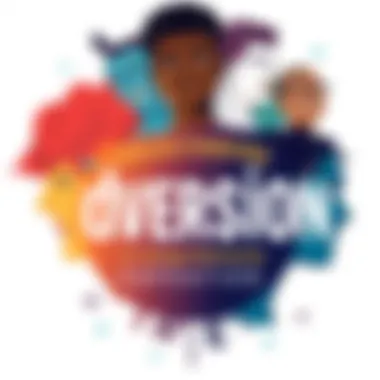Understanding Diversity Education in Schools


Intro
In the ever-evolving landscape of educational philosophy, the significance of diversity education has increasingly come to the forefront. As classrooms become melting pots of cultures, backgrounds, and perspectives, understanding diversity education means appreciating not just its definition but also its intrinsic value in shaping inclusive learning environments. This exploration seeks to break down the layers of diversity education, illuminating how concepts like inclusivity and equity weave into the fabric of children's educational experiences.
For educators, parents, and policymakers, grasping the importance of diversity education is akin to wielding a compass in a stormy sea. It equips them with the knowledge and strategies to foster a holistic learning environment. In this context, the following sections will delve into various aspects of this crucial topic, underscoring the practical implications and challenges that come into play within educational settings.
Interactive Learning Games
Engaging students through play is a timeless strategy that cultivates both learning and creativity. Interactive learning games have emerged as a powerful tool in diversity education, making complex topics more accessible and enjoyable.
Popular Games
Among the wealth of resources available, games like Kahoot!, Minecraft: Education Edition, and Classcraft stand out. Each game serves as a bridge to foster inclusivity and multicultural understanding.
- Kahoot! allows educators to create interactive quizzes that can be tailored to include diverse cultural references, enhancing engagement with varied backgrounds.
- Minecraft: Education Edition invites learners to collaborate in building projects reflective of cultural sites or historical events.
- Classcraft integrates role-playing elements, where students can take on diverse character backgrounds, promoting empathy and understanding among peers.
Description of Top Educational Games
These games are more than mere entertainment; they are foundational tools that nurture skills like teamwork and critical thinking. For instance, Kahoot! blends learning with competition, while Minecraft encourages creative problem-solving within a collaborative framework. Moreover, games like Classcraft emphasize character development and storytelling, fostering an appreciation for different experiences.
"Games that enhance learning foster a sense of community and respect for diverse perspectives."
Benefits of Playing Educational Games for Kids' Cognitive Development
The impact of educational games extends well beyond enjoyment. Engaging with these games can lead to improved cognitive skills such as:
- Enhanced memory retention through interactive recall practices.
- Strengthened analytical thinking by navigating through challenges and decision-making scenarios.
- Development of social skills via cooperative gameplay.
Game Reviews
In-depth reviews can serve as a guide for educators and parents selecting appropriate games. Each one's unique approach can be evaluated on various criteria, including educational value, engagement, and diversity representation.
In-Depth Reviews of Selected Educational Games
- Kahoot!
- Minecraft: Education Edition
- Classcraft
- Pros: User-friendly, customizable, promotes participation.
- Cons: Overreliance may diminish deeper cognitive engagement.
- Pros: Offers an immersive experience, promotes creative thinking and cultural appreciation.
- Cons: Requires a degree of tech-savviness.
- Pros: Fosters a sense of community and encourages behavior management through incentives.
- Cons: Learning curve involved in setup and implementation.
Comparison of Gameplay and Learning Outcomes
When weighing gameplay against educational benefits, one must consider how each game aligns with learning objectives. Engaging in collaborative games often correlates with improved social interactions among diverse groups, leading to positive learning outcomes.
Educational Topics
Diversity education also spans various subjects, intertwining disciplines like math, science, and languages. Emphasizing interdisciplinary learning, it creates a rich tapestry of knowledge.
Compilation of Articles Covering Various Subjects
Articles exploring math's application in understanding global cultures or science's relevance in environmental issues can shed light on interconnectedness in education.
Importance of Interdisciplinary Learning for Holistic Development
By integrating multiple subjects, educators can cultivate well-rounded students equipped with diverse skills and perspectives, preparing them for a more intricate world.
Tips and Tricks
For parents and educators looking to enhance children's learning journey, practical strategies can make a significant difference.
Practical Tips for Parents and Educators
- Encourage storytelling that draws from multiple cultural backgrounds to enrich children's narrative building.
- Utilize local community resources or cultural workshops to connect theoretical lessons with real-life examples.
Strategies for Making Learning Fun and Engaging
- Gamify classroom discussions by introducing quizzes or friendly competitions that incorporate diverse topics.
- Implement creative projects that allow children to express their cultures or explore others, enhancing empathy and understanding.
Creative DIY Projects
Hands-on activities can serve as a prime avenue for introducing diversity and creativity into the learning process.
Step-by-Step Guides
Projects that celebrate different cultures provide a valuable opportunity for students to embrace diversity actively.


Craft Ideas
For instance, crafting flags from around the world not only promotes artistic skills but also educates children about various nations and cultures. Using simple household items, such as paper and colors, can lead to a creative experience that embodies expressions of identity.
This multifaceted exploration aims to lay the groundwork for understanding diversity education's importance in shaping a vibrant learning experience for children. As we proceed, each aspect discussed will contribute to a clearer picture of how diversity education can truly enrich educational environments.
Defining Diversity Education
Understanding what diversity education is begins with recognizing the myriad ways in which it manifests in our communities and classrooms. At its core, diversity education aims to equip students with the knowledge, skills, and attitudes necessary to navigate an increasingly interconnected world. This approach not only fosters an appreciation for varied perspectives but also promotes inclusivity and mutual respect.
The Concept of Diversity
Diversity encompasses various dimensions, including race, ethnicity, age, gender identity, sexual orientation, and socioeconomic status. When examining the concept of diversity, it becomes clear that it goes far beyond mere acknowledgment of differences. It involves actively engaging with these differences to cultivate a deeper understanding of one another. For instance, in a classroom where students hail from different cultural backgrounds, teachers can create opportunities for dialogue that highlight unique traditions or values, enriched by real stories rather than mere textbooks.
This type of engagement doesn’t just raise awareness; it helps students internalize the notion that every person’s story adds invaluable depth to our collective experience.
Understanding Education
Education, in this context, is not a standalone entity. It’s the vehicle through which diversity education achieves its aims. Understanding education involves recognizing how learning environments, teaching methods, and curricular content must adapt to include the rich tapestry of identities present in student bodies. It's essential to highlight that education is a two-way street. Teachers impart knowledge, but they also learn from their students.
When educators understand their students' diverse backgrounds, they can tailor their teaching strategies to better meet the needs of all students. This is not merely about adapting lessons; it’s about reshaping the educational landscape. Imagine a history lesson that integrates multiple perspectives on a significant event, encouraging students to think critically about whose voices are being heard - and whose are not.
The Intersection of Diversity and Education
The intersection of diversity and education presents a unique opportunity. This overlap allows for a holistic approach to learning that values multiple viewpoints. It suggests that education should reflect societal diversity, preparing students to function in a global context.
Real-world examples, like schools implementing multicultural curricula, showcase the benefits of this intersection. They help students not only to learn about different cultures but also to develop empathy and interpersonal skills, essential tools for navigating a complex world.
An effective strategy here is to involve students in project-based learning that addresses real-world diversity issues. For instance, a project could focus on local community dynamics, encouraging students to interview residents from different backgrounds about their experiences. This methodology enriches the educational experience, allowing students to engage directly with diverse narratives.
"Diversity education opens doors to understanding not just our similarities, but the beauty of our differences."
Importance of Diversity Education
Diversity education is no longer just a buzz word—it is a crucial component in shaping the educational landscape of the 21st century. The importance of this topic cannot be overstated; it impacts not only the educational sphere but also the larger society. By incorporating diversity education into curricula, we can consciously create an environment that nurtures inclusive practices, promotes critical analytic thinking, and supports the aspiration of social equity. Understanding these elements is vital for stakeholders including educators, parents, and policymakers.
Fostering Inclusivity
Fostering inclusivity is perhaps the cornerstone of diversity education. An inclusive educational setting resonates with the idea that all students, regardless of their backgrounds, identities, or experiences, have a rightful place in the learning environment. This isn't about merely acknowledging differences but actively engaging with them.
An inclusive classroom allows students to feel seen and valued, leading to increased participation and a sense of belonging. For instance, when teachers integrate diverse cultural perspectives into their lesson plans, they validate the experiences of all students. By doing so, they establish a community where everyone feels connected, which in turn boosts overall morale among students.
The benefits of fostering inclusivity extend beyond improved social dynamics. Research has shown that inclusive practices contribute to higher academic achievement and emotional well-being among students. Creating an environment where every voice is heard encourages students to express their ideas freely. Ultimately, this cultivates not just academic success but also lifelong skills in empathy and collaboration.
Enhancing Critical Thinking
Diversity education stands out for its capacity to enhance critical thinking among students. When students are exposed to a multitude of perspectives, it prompts them to analyze information from various angles. This is not merely about memorizing facts or regurgitating information but engaging in deeper thought processes.
For example, in a discussion about climate change, rather than sticking to a single narrative, students can explore how different cultures approach environmental issues. Faced with contrasting viewpoints, they learn to weigh evidence, challenge their assumptions, and arrive at reasoned conclusions.
This kind of critical engagement is essential. By debating, discussing, and collaborating with peers from different backgrounds, students hone their analytical skills. They develop the competency to navigate complex issues, which is increasingly vital in our interconnected world. In essence, education morphs from passive learning into an active, thoughtful exploration of ideas.
Promoting Social Equity
Promoting social equity is a goal that aligns closely with diversity education. The disparities existing within educational institutions often reflect broader societal inequalities. By embedding principles of social justice within the curriculum, educators can play a significant role in countering these inequities.
When students learn about social justice, they are better equipped to understand the structures of power and privilege that affect different groups. An example can be seen in curriculum materials that highlight the contributions and histories of marginalized communities. Highlighting such narratives enables students to question the status quo and recognize the importance of equitable treatment for all.
Understanding social equity does not just stop at recognizing disparities; it extends to encouraging students to take action. Through community service projects, students can engage with their local communities, fostering real-world connections and events that confront issues such as poverty, racism, and inequality. This bridges the gap between education and real-life activism, ultimately helping to cultivate an informed citizenry ready to advocate for change.
"Diversity education must evolve to not only teach about differences but also empower students to engage in social justice."
Frameworks of Diversity Education
Diversity education encompasses various frameworks that serve as the cornerstone for integrating inclusive practices in educational settings. These frameworks not only offer structure but also present practical methodologies for addressing the complexities of diverse student bodies. By embracing these frameworks, educators can create curricula that are not just inclusive but also reflective of the real world, emphasizing equity and access for every child, regardless of their background.
Multicultural Education
Multicultural education is a pivotal element in diversity frameworks, focused on the rich tapestry of cultures present in any educational institution. It aims to validate and affirm the identity of all students while fostering an understanding of their own cultural contexts. In practice, this can manifest through curriculum design that incorporates literature, history, and perspectives from various cultures.
Imagine a classroom where students read stories from authors hailing from different backgrounds, or learn about historical events from diverse viewpoints. This enriches their educational experience and allows them to see the world from multiple angles. Here are some potential benefits of implementing multicultural education:
- Increased cultural awareness: Students become more informed about various cultures, leading to greater empathy and understanding.
- Broader perspectives: Encourages critical thinking by presenting multiple viewpoints on issues.
- Positive self-identity: Students can connect with the materials that reflect their own cultural experiences.
Social Justice Education
Social justice education seeks to address systemic inequalities and empower students to become advocates for change. This framework encourages a proactive approach that goes beyond mere awareness of diversity. It emphasizes the individual’s role in combating injustice, which can be pivotal in shaping a well-rounded educational experience.
Incorporating social justice into educational practices involves more than just discussing issues of inequality; it encompasses teaching students how to engage with these issues creatively and thoughtfully. Key components of social justice education may include:
- Critical analysis of societal structures: Understanding how various societal factors contribute to inequality.
- Activism and advocacy: Providing students with tools and opportunities to effect real change in their communities.
- Collaborative projects: Working together on initiatives that promote equity, enhancing teamwork and community engagement.
Culturally Relevant Pedagogy
Culturally relevant pedagogy that positions students' cultural references in all aspects of learning. This framework is crucial as it recognizes the strengths that students bring to the classroom, including their unique cultural backgrounds, experiences, and languages. It encourages educators to adapt their teaching methods to fit these diverse cultural contexts.


For example, an educator might design lessons that draw on students' home languages or cultural artifacts. Rather than viewing these elements as barriers, they become valuable assets to enhance the learning experience. The principles of culturally relevant pedagogy include:
- Academic success: Ensuring that all students receive the tools needed to succeed academically while respecting their cultural backgrounds.
- Cultural competence: Helping students navigate and thrive in diverse environments.
- Critical consciousness: Fostering an awareness of social issues and an understanding of how to address them within their own communities.
"Education that is inclusive and reflective of cultural diversity contributes significantly to students' engagement and achievement."
In summary, the frameworks of diversity education—multicultural education, social justice education, and culturally relevant pedagogy—offer effective strategies for educators. They form a comprehensive approach to support diverse learners, ensuring that the educational environment respects and celebrates the differences that contribute to a rich learning experience.
Components of an Effective Diversity Curriculum
An effective diversity curriculum is not just about mandating text inclusions or modifying lesson plans; it fundamentally reshapes how students perceive and engage with the world around them. It serves as a crucial scaffold for learners, providing the necessary tools and perspectives to nurture an understanding of our multifaceted society. A well-structured curriculum can empower students, making them thoughtful global citizens equipped to tackle significant challenges faced by diverse communities today.
Curriculum Design Principles
When designing a diversity curriculum, several core principles must guide its creation. These are not merely theoretical ideals but practical strategies to create relevance and recognition of all students' experiences. Here are a few important ones:
- Relevance: Curriculum material should speak to the lives of all students. It comes from who they are and where they come from. This can mean including literature by underrepresented authors or discussing historical events from various perspectives.
- Interconnectedness: Topics should not only address diversity in isolation but intertwine with other subject matter. For instance, discussing social justice should connect with historical events, literature, and even scientific advancements.
- Flexible Structures: Recognizing that every classroom is unique, a diversity curriculum must allow for adaptability. Whether adjusting to the needs of students with diverse learning goals or accommodating different teaching styles, flexibility is key.
- Collaborative Learning: Encourage students to work together on projects that emphasize shared experiences and diversity. Group works can help students learn from one another, enhancing mutual respect and understanding of their various backgrounds.
By adhering to these principles, educators can create a curriculum that resonates, ensuring that all students feel seen and heard, fostering deeper connections to their educational experience.
Inclusive Learning Environments
Creating an inclusive learning environment is the backbone of an effective diversity curriculum. It is where theoretical knowledge meets practice in action. An inclusive classroom fosters respect and understanding, where every individual feels valued. Here are some essential considerations:
- Physical and Emotional Safety: The classroom should be a place free from bias, discrimination, and hostility. When students feel safe emotionally and physically, they are more likely to participate and engage openly.
- Diverse Resources: Incorporating various instructional materials, such as books, media, and guest speakers from diverse backgrounds, enriches discussions and perspectives offered in the classroom setting.
- Encouraging Diverse Voices: Allowing all students space to express themselves through discussions, projects, and presentations promotes a richer learning experience. It is critical to encourage students to draw on their backgrounds for relevant contributions.
The aim is to cultivate not just acceptance but appreciation of differences. With such an environment, students can develop critical skills in empathy, cooperation, and communication, all necessary in a diverse society.
Assessment Strategies
Assessing students in a diversely focused curriculum requires thoughtful techniques that reflect the inclusivity of the classroom. Traditional assessments may not accurately showcase students’ understanding or appreciation of diverse concepts. Therefore, educators might explore several innovative strategies:
- Portfolio Assessments: Instead of standardized tests, educators can have students compile their work over time. This offers a more comprehensive view of their learning journey.
- Peer Assessments: Students assess each other’s contributions and understanding, fostering critical thinking and collaboration skills.
- Project-Based Learning: Assigning projects that require research on diverse cultures, histories, or global issues serves as a practical assessment of their learning in action.
- Self-Reflection: Encouraging students to reflect on their own learning experiences regarding diversity can uncover personal growth and understanding.
These strategies not only evaluate students’ academic accomplishments but also their ability to think critically and empathetically about the world around them.
In essence, the components of an effective diversity curriculum must intertwine thoughtfully designed principles, inclusive environments, and innovative assessment methods. This approach transforms education into a meaningful journey for all students, equipping them with the knowledge and understanding necessary to thrive in a diverse society.
Challenges in Diversity Education
Diversity education comes with its own set of hurdles that educators and institutions must tackle head-on. Acknowledging these challenges helps identify solutions and paves the way for a more inclusive educational experience. The discussion about these challenges is not just about recognizing the difficulties but also about understanding how overcoming them can significantly enhance the learning environment.
Resistance to Change
One major challenge in diversity education is the resistance to change that can often be encountered. Many educational institutions operate within a traditional framework that may not be conducive to incorporating diverse perspectives and practices.
Individuals, be it administrators, teachers, or even parents, can sometimes be hesitant to embrace new approaches. This reluctance to shift existing paradigms stems from comfort with the status quo or fears of the unknown. Overcoming this resistance requires consistent communication about the benefits of diversity education. When stakeholders realize that embracing diversity not only enriches the educational experience but also better prepares students for a globalized world, it becomes easier to foster a positive attitude toward change. Moreover, as educational discourse continues to evolve, presenting compelling data and case studies can further ease the transition, creating a culture that values diversity.
Limited Resources
Another significant barrier is the often limited resources for implementing effective diversity education. Many schools face budget constraints that hinder their ability to provide necessary materials, training, and support. Moreover, even within well-funded districts, the allocation of resources may prioritize standardized testing and core curriculum at the expense of diversity initiatives.
To navigate this challenge, educators can harness creativity. Initiatives such as partnerships with local community organizations or inter-school collaborations can prove invaluable. Schools might also consider crowdfunding for diversity-related projects or tapping into grants aimed at enhancing educational opportunities for underrepresented groups. Collaboration can be a powerful tool – by sharing resources and expertise, institutions can create a more robust diversity framework without straining their budgets excessively.
Misunderstandings of Diversity Concepts
Misunderstanding the concept of diversity is yet another roadblock in implementing effective diversity education. Many people associate diversity strictly with race or ethnicity, neglecting other essential factors such as gender, socioeconomic status, disability, and LGBTQ+ identities. Failure to grasp the full scope of diversity can lead to incomplete and ineffective educational strategies that do not address the needs of all students.
Educators must emphasize a broad understanding of diversity that goes beyond superficial indicators. This can involve integrating comprehensive discussions around cultural nuances and histories across all curricula. Workshops, professional development, and inclusive dialogues about different forms of identity can further enhance understanding among educators and students alike. By making diversity education relevant and relatable, misunderstandings can begin to dissolve.
"It is essential for education to reflect the society it serves, ensuring all voices are heard and acknowledged."
As educators and policymakers continue to navigate the complexities of diversity education, recognizing these challenges will allow for more constructive dialogue and the development of tailored solutions. Addressing resistance, resource limitations, and misconceptions about diversity concepts will ultimately lead to richer educational experiences for all students.
Implementing Diversity Education
Implementing diversity education isn’t just a checkbox on a list; it’s a vital part of creating a learning environment where all students can flourish. The importance of integrating diversity education into schools can't be overstated. It provides both the framework and the opportunities needed for students to learn in a world that is rich with diverse cultures, ideas, and perspectives. Schools that implement these strategies tend to see not only an increase in student engagement, but also in their overall well-being and academic performance.
Best Practices
To effectively implement diversity education, best practices must be observed. These principles create a roadmap for educators, ensuring that diversity is woven into the fabric of the educational experience.
- Inclusive Curriculum Design: Incorporating materials that reflect diverse perspectives helps foster a sense of belonging among all students.
- Interactive Learning Techniques: Use group projects and discussions that challenge students to collaborate with their peers from different backgrounds.
- Assessment of Bias and Inclusion: Regular audits are necessary to identify and remove biases within curricular and extracurricular activities.
This approach not only enriches the academic experience but also promotes social awareness. Schools that prioritize these best practices are often recognized as leaders in progressive education.
Professional Development for Educators


The role of educators is crucial in the effective implementation of diversity education. They must be equipped with the right tools and knowledge to foster an inclusive atmosphere. Professional development opportunities should focus on several key areas:
- Understanding Implicit Bias: Training to recognize their own biases allows educators to create a more equitable learning space.
- Culturally Responsive Teaching: Workshops that focus on culturally aware approaches can help teachers connect with a diverse student body effectively.
- Collaboration with Diversity Experts: Partnering with specialists can provide teachers with actionable strategies and sustained support, ensuring they feel confident in navigating diverse scenarios.
Community Engagement Strategies
Engaging with the community is another cornerstone of successfully implementing diversity education. Local communities can offer rich resources and perspectives that enhance students' learning. Schools should consider these strategies:
- Local Partnerships: Collaborate with cultural organizations to host events that celebrate diverse backgrounds, allowing students to see their own cultures reflected in the school.
- Family Involvement: Promote family nights where parents share their cultural stories, traditions, and cuisines, integrating these into students' learning experiences.
- Service Learning Opportunities: Encourage students to participate in community service projects that expose them to diverse communities and foster empathy.
Implementing diversity education is not just beneficial; it's necessary for developing well-rounded, situation-ready students who understand the complexities of the world they live in. As we cultivate more inclusive classrooms, we become educators and advocates for a broader understanding of diversity that will prepare our students for the future.
Case Studies in Diversity Education
Exploring real-world applications of diversity education through case studies serves as a cornerstone for understanding its practical impacts and benefits. By highlighting successful instances, these case studies provide relevant insights into how educational institutions can effectively foster inclusive environments. They not only illustrate principles in action, but also showcase the tangible outcomes that arise from implementing diversity initiatives. Each case study offers a unique glimpse into the obstacles faced, the strategies employed, and the results achieved—making it easier to visualize how concepts translate into everyday teaching and learning.
Successful Implementations
Taking a closer look at successful implementations, various educational institutions have taken significant steps toward integrating diversity education effectively. For instance, Oakwood High School in California initiated a comprehensive diversity program that includes a diverse curriculum, training for teachers, and workshops for students. This program emphasizes multicultural literature and historical perspectives that represent various backgrounds. As a result, there has been a marked improvement in student engagement and participation during discussions.
Furthermore, Greenwood Middle School in Maryland launched a peer mentorship program that pairs students from different backgrounds to foster friendships and understanding. The outcome was quite promising. Reports show a reduction in bullying incidents and an increased sense of community among students. Educational leaders emphasize:
"When students connect with one another, they become more accepting and empathetic, which transforms the entire school culture."
Lessons Learned
Through these implementations, multiple lessons can be gleaned that are crucial for anyone looking to build or enhance their diversity education efforts. One significant lesson is the importance of community involvement. Schools that engage parents and local organizations tend to achieve greater success. Broadview Academy in Indiana found a way to involve parents in their diversity workshops, significantly amplifying the program's reach and effectiveness.
Another crucial factor is the need for continuous training for educators. In Riverbank Elementary School, teachers participated in ongoing professional development workshops focused on diversity and inclusivity. This led to innovative teaching methods and greater awareness of students' varied cultural contexts. As educators grow in their understanding, they become better equipped to meet the diverse needs of their students.
Yet another lesson is the importance of utilizing student feedback. When Lakeside Institute implemented surveys to collect students' perspectives on their experiences, the results led to necessary adjustments in their programs. By actively listening, schools can adapt strategies to better fit the community’s needs.
Impact on Student Outcomes
The impact of diversity education on student outcomes cannot be overstated. Numerous studies and reports have shown that when schools incorporate diversity programming, students experience improved academic achievement, along with social and emotional benefits. For instance, a longitudinal study conducted at Hillside College indicated that students exposed to multicultural curricula demonstrated higher critical thinking skills compared to peers in traditional settings.
Additionally, students often report feeling more accepted and understood in environments that prioritize diversity education. An analysis from New Haven Public Schools revealed that students involved in diversity programs were significantly more likely to view their peers with different backgrounds positively. This fostered a sense of belonging, which is pivotal for mental health.
Moreover, the increased collaboration among students aids in preparing them for real-world scenarios, where they will encounter diverse viewpoints and cultures. Employers increasingly look for graduates who are not only knowledgeable but also socially aware and inclusive. In this regard, schools that prioritize diversity education are not just preparing students for academic success but also for their future careers.
Future Directions in Diversity Education
Diversity education is continually evolving. In the ever-changing landscape of global societies, the importance of understanding and adapting to diverse backgrounds becomes vital. Looking toward the future, education stakeholders must consider emerging trends, innovative strategies, and the role technology will play in shaping effective approaches. This section discusses the significance of future directions in diversity education, focusing on critical elements that can benefit various educational environments.
Trends to Monitor
As societies become more interconnected, several trends should be observed to ensure that diversity education evolves in a meaningful way. By paying attention to these patterns, educators can make informed decisions that reflect the needs and realities of their student populations.
- Increased Cultural Competence: Schools are expected to promote cultural awareness among staff and students alike. Understanding the identities and experiences of different cultures leads to better communication and collaboration within the school community.
- Global Perspectives: With the rise of globalization, incorporating a global lens into diversity education will help students appreciate different worldviews. This can enhance empathy and understanding, crucial for cooperation in a multicultural world.
- Social Emotional Learning (SEL): Integrating SEL into diversity programs can foster not just intellectual understanding, but also emotional connections among students, enabling more profound insights into their peers' experiences.
Innovative Approaches
Diversity education doesn't have to stick to conventional methods. There are fresh and creative strategies being developed that can revolutionize the way this subject is taught. Here are a few noteworthy approaches:
- Project-Based Learning: This approach encourages students to solve real-world problems that affect their communities. By working in teams on projects related to diversity, students learn to listen, collaborate, and create tangible solutions.
- Interdisciplinary Curriculum: Blending subjects such as history, literature, and social studies can create comprehensive lessons that highlight diversity from multiple perspectives. This encourages students to make connections and engage in critical thinking.
- Student-Led Initiatives: Empowering students to create their own programs and events can cultivate leadership while allowing young people to take ownership of their learning and the cultural dialogue within their schools.
The Role of Technology
Technology's influence on diversity education is undeniable. It provides numerous tools and resources to enhance the learning experience, making it more accessible and engaging.
- Online Platforms for Collaboration: Using platforms such as Edmodo or Google Classroom, students can connect with their peers from diverse backgrounds globally. These interactions can provide opportunities for discussion and collaboration that transcend geographic boundaries.
- Multimedia Resources: Incorporating films, podcasts, and interactive websites can make lessons more engaging and relatable. Visual storytelling and diverse narratives create a richer educational experience.
- Data-Driven Insights: Technology can also be utilized to analyze student demographics and needs. Educators can leverage this data to identify gaps in understanding and tailor their lessons accordingly.
Investing in these future directions not only prepares students for a multicultural world but also fosters a more inclusive society where everyone can thrive.
By looking ahead and integrating these trends, innovative methods, and technology into diversity education, society can create a more equitable and understanding future. This ongoing commitment will ensure that all students, regardless of their background, develop the skills needed to navigate an increasingly diverse world.
Finale
The final thoughts in any article serve not only to summarize what has been discussed but also to remind the reader of the journey they've just taken. In the realm of diversity education, this conclusion echoes vital themes like inclusivity, equity, and the transformative power of an inclusive educational environment. It is essential to understand that the conversation doesn't end here; these concepts should inspire continuous reflection and action.
Summary of Key Points
As we've explored, diversity education is far from a peripheral consideration in the schooling system.
- Broader Understanding: It emphasizes understanding diverse perspectives and backgrounds, preparing students to thrive in a multicultural world.
- Critical Engagement: An inclusive curriculum encourages critical thinking, challenging stereotypes and promoting understanding.
- Real-World Impacts: Successful implementations showcased in various case studies highlight the positive outcomes of diversity education on student engagement and success.
The importance of these points cannot be overstated; they are the foundation upon which effective diversity education is built. As our society continues to evolve, the principles discussed will need to be woven into every fabric of the educational process.
Call to Action for Educators
Now, it's time for educators to rise to the challenge.
- Integrate Diversity in Curriculum: Actively include diverse narratives and voices in lesson plans to enrich the learning experience.
- Create Supportive Environments: Foster classrooms where every student feels safe to express their individuality and perspectives.
- Engage with Families and Communities: Collaborate with parents and local communities to acquire insights and resources that reflect their cultures and experiences.
As we move forward, let every educator become a champion of this cause, recognizing the profound effect they can have on students’ lives by promoting diversity. The ripple effect of these actions extends well beyond the classroom, producing generations that are not only educated but also empathetic citizens.















